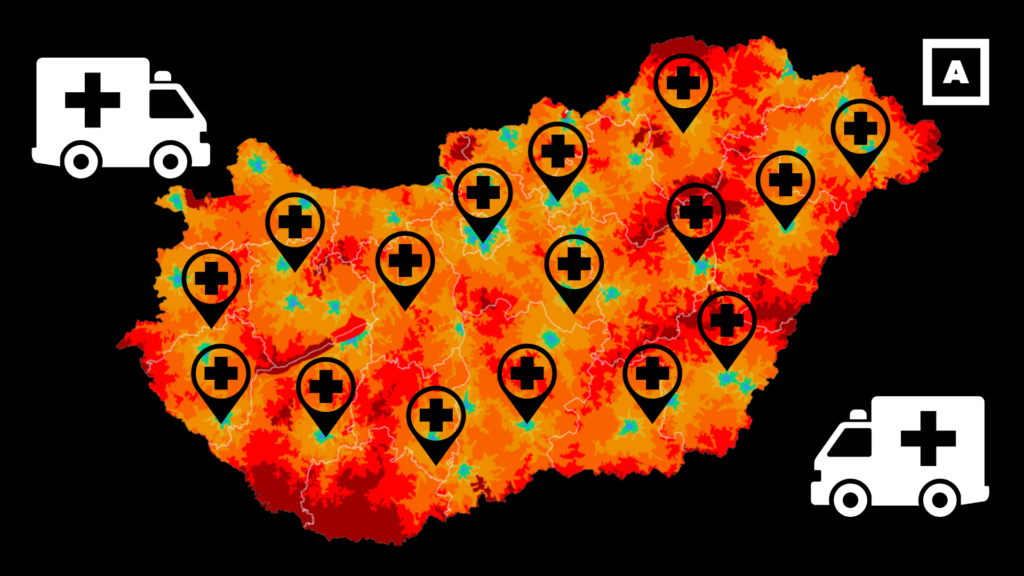The https://english.atlatszo.hu use cookies to track and profile customers such as action tags and pixel tracking on our website to assist our marketing. On our website we use technical, analytical, marketing and preference cookies. These are necessary for our site to work properly and to give us inforamation about how our site is used. See Cookies Policy
Three quarters of the Hungarian population have no access to immediate hospital care
Of the 155 hospitals operating in Hungary, only 44 are capable of providing the main services required for active inpatient care. In other words, barely a third of these institutions have internal medicine, surgical, obstetrics, and emergency departments. Moreover, three-quarters of the population live more than a 15-minute drive away from these hospitals. And 15 minutes can be vital for someone in a serious, life-threatening medical condition (e.g., heart attack, premature birth, suffocation, severe bleeding): the patient’s life can easily be lost if they do not receive hospital care within a few minutes.
There are few other EU countries like Hungary where people have to travel so far by car to reach the nearest hospital. According to Eurostat data for 2023, only 65% of the Hungarian population (6.4 million people) live within 15 minutes of a healthcare facility or hospital.

According to Eurostat data, even in the northernmost parts of Finland and Sweden, 82% and 72% of the population, respectively, can reach a hospital within a 15-minute drive. In the two largest EU member states, Germany and France, this ratio is nowhere below 50%, with an average of 80-90%.
In contrast, the average in Hungary is 60 percent, with the best figures coming from Budapest (99 percent) and Győr-Moson-Sopron County (79.7 percent).
The worst ratio is in Békés County, where only 29.5 percent of the population lives close to hospitals
(within a maximum of 15 minutes), but this ratio is also below 50 percent in Szabolcs-Szatmár-Bereg (33.5%), Bács-Kiskun (39.7%) and Hajdú-Bihar (41%) counties. Jász-Nagykun-Szolnok County is just above 50% (51.7%), but the situation is not much better in Tolna (51.8%), Baranya (54.1%), Vas (53.8%) and Nógrád (55.5%).
Fifteen minutes may not sound like much, but in a serious, life-threatening medical condition (e.g., heart attack, premature birth, accident involving severe bleeding, or drowning), it can be decisive: the patient’s life may easily be lost if they do not receive hospital care within a few minutes. This is why it is important to know what percentage of residents can reach a hospital within 15 minutes – their chances of survival are higher.
In Austria, often cited as an example to be followed by the Hungarian government, an average of 70 percent of the population lives within 15 minutes of a hospital. The situation is worst in the middle of the Tyrolean mountains, where it is 49.6 percent, which is still much better than in many counties in Hungary.
Eurostat, however, includes all healthcare institutions in its calculations, of which there were 155 in Hungary according to NEAK data for 2024: 82 were central healthcare institutions, 17 were municipal healthcare institutions, 4 were university clinics, 21 were businesses, 9 were church institutions, and 22 were other healthcare institutions.
Incidentally, their number has gradually decreased over the past 15 years.
What is more interesting, and gives a better approximation, is
how far away are the hospitals that can actually perform the most important tasks of a hospital?
That is, they provide active inpatient care in at least two of the following areas: internal medicine, surgery, obstetrics, and emergency care. The definition of county hospitals differs from this (they must provide care in at least five of 21 specialties), but these four most important areas are still found in these hospitals, so we only took this criterion into account for all hospitals.
The definition significantly reduces the list of institutions registered as hospitals by the National Health Insurance Fund of Hungary (Hungarian acronym: NEAK): institutions caring for chronic patients or providing rehabilitation services have been removed from the list, as have a number of institutions providing active inpatient care, because none of the four departments are found in the hospital. In addition, we also looked at whether there were any department closures or transfers to other hospitals within the four departments examined in the remaining institutions.
Thus, of the 155 institutions registered by NEAK, only 61 remained in which at least one of the four departments (internal medicine, surgery, obstetrics, emergency) could be found. Narrowing it down further:
- 57 hospitals where at least two departments could be found,
- 55 with at least three,
- and 44 with all four departments.
The number of institutions is slightly higher if we also take into account the member hospitals of each hospital. 87 institutions have at least one of the four departments, 68 have at least two, 64 have at least three, and 48 have all four departments examined.
However, only a quarter of the population can reach these hospitals/member hospitals within a very short time (a maximum of 15 minutes by car).
The majority of the Hungarian population, more than 7 million people, have to drive more than 15 minutes to receive basic hospital care.
Nearly half a million people have to travel more than an hour to reach the nearest hospital.
Written and translated by Krisztián Szabó. The original Hungarian story can be found here. Cover image: montage by Átlátszó. We used the ORS Tools extension of the QGIS mapping application to calculate distances. Population coverage was also calculated using the QGIS application. These calculations should be interpreted as estimates only.

